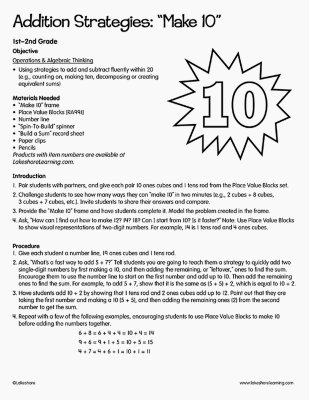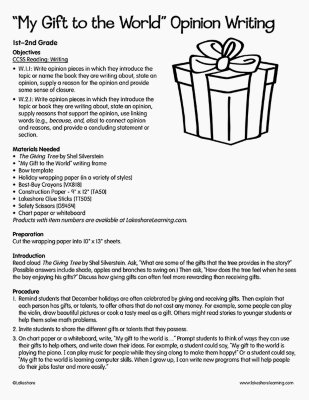Narrow by Grade
Grade
3 results for "ten frame"
Addition Strategies: "Make 10"
1st Grade - 2nd Grade
Objective Operations & Algebraic Thinking Using strategies to add and subtract fluently within 20 (e.g., counting on, making ten, decomposing or creating equivalent sums) Materials Needed “Make 10” frame Place Value Blocks Number line “Spin-To-Build” spinner “Build a Sum” record sheet Paper clips Pencils Introduction Pair students with partners, and give each pair 10 ones cubes and 1 tens rod from the Place Value Blocks set. Challenge students to see how many ways they can “make 10” in two minutes (e.g., 2 cubes + 8 cubes, 3 cubes + 7 cubes, etc.). Invite students to share their answers and compare. Provide the “Make 10” frame and have students complete it. Model the problem created in the frame. Ask, “How can I find out how to make 12? 14? 18? Can I start from 10? Is it faster?” Note: Use Place Value Blocks to show visual representations of two-digit numbers. For example, 14 is 1 tens rod and 4 ones cubes.
View Lesson PlanMy Gift to the World Opinion Writing
1st Grade - 2nd Grade
Objectives CCSS Reading: Writing W.1.1: Write opinion pieces in which they introduce the topic or name the book they are writing about, state an opinion, supply a reason for the opinion and provide some sense of closure. W.2.1: Write opinion pieces in which they introduce the topic or book they are writing about, state an opinion, supply reasons that support the opinion, use linking words (e.g., because, and, also) to connect opinion and reasons, and provide a concluding statement or section. Materials Needed The Giving Tree by Shel Silverstein “My Gift to the World” writing frame Bow template Holiday wrapping paper (in a variety of styles) Best-Buy Crayons Construction Paper - 9" x 12" Lakeshore Glue Sticks Safety Scissors Chart paper or whiteboard Preparation: Cut the wrapping paper into 10" x 13" sheets. Introduction Read The Giving Tree by Shel Silverstein. Ask, “What are some of the gifts that the tree provides in the story?” (Possible answers include shade, apples and branches to swing on.) Then ask, “How does the tree feel when he sees the boy enjoying his gifts?” Discuss how giving gifts can often feel more rewarding than receiving gifts.
View Lesson PlanCounting Apples
Kindergarten
Objectives CCSS Math/Counting & Cardinality K.CC.B.4: Understand the relationship between numbers and quantities; connect counting to cardinality. K.CC.B.5: Count to answer “how many?” questions about as many as 20 things arranged in a line, a rectangular array, or a circle, or as many as 10 things in a scattered configuration; given a number from 1?20, count out that many objects. Materials Needed The Very Hungry Caterpillar by Eric Carle Apple Doodle Apple Accents or large apple template and Construction Paper - 9" x 12" (red) Apple Tree counting mat Apple counters (20 per student) Thin-Line Permanent Markers - Black Photo of each student from the shoulders up (Photos shouldn't measure more than 4" high.) Construction Paper - 12" x 18" “I have ______ apples up on top!” writing frame Lakeshore Glue Sticks Safety Scissors Tape Preparation: Count out a set of 20 Apple Doodle Apple Accents and use a marker to number them from 1 to 20. Or, if you prefer, download and print out the large apple template and trace it onto red construction paper. Use scissors to make 20 large apple cutouts, and then number the cutouts from 1 to 20. Introduction Read aloud The Very Hungry Caterpillar by Eric Carle. As you read, point to the apples on top of the characters? heads and have the class count them aloud together.
View Lesson Plan

